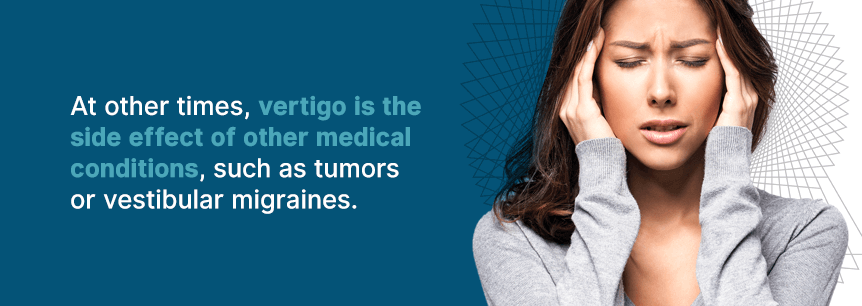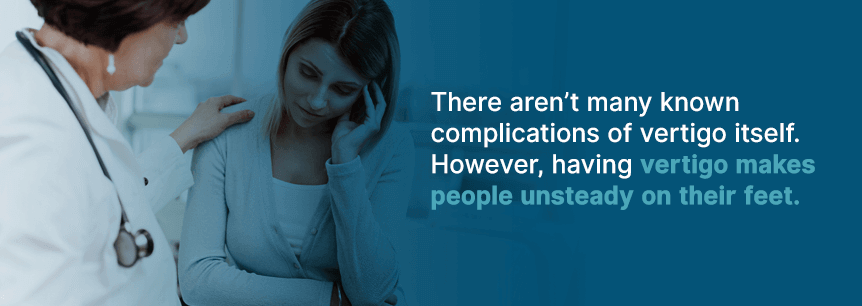
For patients with vertigo, an inner ear disorder that affects your hearing and balance, medical marijuana could provide relief. Studies have shown that medical cannabis can help manage common symptoms of vertigo from nausea to inflammation. Learn more about vertigo, how symptoms affect patients, and how patients can begin using medical marijuana to find relief from vertigo.

Medical marijuana seems to activate specific endocannabinoid receptors in the body, mostly in the central nervous system. There are two primary cannabinoid receptors — CB1 and CB2. The CB1 receptor is in the central nervous system, whereas the CB2 receptor is primarily in immune cells, regulating cytokine release.
Scientists studying cannabis’s effects have made various important discoveries after many years of research. They have identified many components of marijuana called cannabinoids as well as how these components impact the brain and body through the endocannabinoid system (ECS). The ECS, named after the cannabis plant, is a distinct communications system in the body and brain, affecting many essential functions, including how you move, feel and react.
Endocannabinoids are your body’s natural chemicals that interact with your ECS. The cannabinoids in marijuana interact with your ECS in similar ways. The two most common cannabinoids are tetrahydrocannabinol (THC) and cannabidiol (CBD). THC produces psychoactive effects and causes the “high” associated with marijuana. CBD is not psychoactive and is associated more with body effects. It also reduces the effects of THC and doesn’t exhibit effects that could lead to dependence or abuse. Additionally, there’s no evidence of any health related issues linked with pure CBD use.
Although there are limited studies on medical marijuana for vertigo, anecdotal reports from patients using CBD offer the potential of a good response for treating dizziness. This could be due to the anti-seizure effects specific cannabis components provide.
Some of vertigo or dizziness spell symptoms marijuana and vertigo treatment could help with include:
Following a severe episode, many individuals feel the need to sleep for a few hours. Fortunately, there are many sativa cannabis strains that could help energize and uplift these individuals.
Find A Doctor Find A Dispensary
Let’s explore further how medical weed can help relieve these vertigo symptoms.
Physicians have successfully indicated both psychoactive and non-photoactive forms of marijuana-based medicines for nearly any type of headache. One study suggests a deficit in endocannabinoids or endocannabinoid system dysfunction could associate with the development of headaches.
THC, CBD and other cannabinoids found in cannabis interact with your ECS receptors, particularly your CB1 receptor, to stop inflammation that leads to headache pain.
Some good strains for headaches are:
Researchers have been studying cannabinoids and their effects on nausea for decades. In one study in 1975, the researchers found all their 20 participants experienced nausea relief after using specific types of THC. More recently, researchers found CBD has antiemetic potential.
Research also shows the antiemetic effects of CBD, THC and other cannabinoids work better than some prescription medicines for nausea.
Almost any cannabis strain can be an effective nausea treatment, but certain strains seem to treat it better than others. Popular nausea-treatment strains include:
Medical pot has been shown effective for treating uncontrollable shaking or jerking movements in conditions like Parkinson’s Disease, Myoclonus, and Spinocerebellar Ataxia, which specifically has symptoms of abnormal eye movements.
Some strains that could help with jerking or abnormal eye movements are:
While these aren’t symptoms specific to vertigo, any person struggling with an ongoing condition can start feeling overwhelmed or depressed about their situation. Medical cannabis has also been proven effective for treating both anxiety and depression.
Some strains you may want to try for anxiety are:
For depression, consider trying:
When using marijuana for medical purposes, there still can be side effects. However, the side effects of cannabis seem to be milder than the side effects of some traditional medications. Some of the side effects of marijuana can even be beneficial to patients such as sleepiness or increased appetite, depending on the patient’s condition.

Some side effects of the herb include:
1. Red eyes: This is a harmless side effect, but it can still embarrass you if you’re concerned with others judging you for using medical cannabis. Red eyes, however, are easily remedied with over-the-counter eye drops.
2. Hunger: Marijuana is well known for giving you the “munchies” or making you hungry. But, this is a good thing for people who have issues eating properly.
3. Drowsiness: An indica strain could cause drowsiness, making you feel sleepy during the day. Being drowsy during the day could impact how you function at school or work. To combat this side effect, you may want to wait until bedtime to use an indica strain or switch to a sativa strain if possible.
4. Respiratory problems: Individuals who smoke or vape the herb could experience breathing issues. If you must inhale your treatment, vaping is your best option.
5. Short-term memory loss: Cannabis could cause you to forget things, but this is a temporary side effect. Your memory goes back to normal once the medicine has worn off. However, you may want to avoid treatment during the day, so you’re not forgetful at work or school.
6. Paranoia: Some cannabis strains could cause feelings of paranoia while on the treatment and after. The cannabinoid most frequently linked with paranoia is THC. If you experience paranoia when using THC strains, you may want to switch to strains high in CBD instead.
Consult with your cannabis doctor about these and other potential side effects of medical marijuana for vertigo. They can help customize a treatment plan that will cause the least amount of side effects as possible.
Another question many patients have when first starting with their medical marijuana treatment is how to use it. CBD oil appears to be a popular method of consumption for many patients. Budtenders extract this oil from high-CBD strains using a variety of solvents. However, they don’t use neurotoxic materials like butane to extract CBD oil as these can leave a dangerous residue in the final products.
Other methods of using cannabis include:
Keep experimenting until you find the method that works best for you and your symptoms.
You no longer need to suffer from the symptoms of vertigo. Feeling dizzy and unbalanced often can be embarrassing. Help control these symptoms with medical marijuana. Marijuana Doctors is your one-stop resource to find a quality cannabis doctor and marijuana dispensary to begin your cannabis treatment.
We have an extensive list of both, making it simple to find the help you need quickly. We also have an extensive resource page to help you get all the information you need to determine if medical weed is right for you.
We’ve helped countless individuals struggling with various conditions and diseases find relief from their symptoms through medical cannabis. Book your appointment to speak with a cannabis doctor and begin your medical marijuana treatment for vertigo today.
Find A Doctor Find A Dispensary
Vertigo is the sensation that you’re moving when you are standing, lying or sitting still. It’s very similar to the feeling you get with motion sickness, and most people describe it as feeling dizzy. However, it’s not the same thing as lightheadedness or motion sickness.
The full extent of people impacted by vertigo is impossible to accurately gauge thanks to widespread misdiagnosis and the failure of many people to seek treatment. The Vestibular Disorders Association (VeDA), however, estimates that nearly 40 percent of Americans over 40 years old have had some type of vestibular dysfunction, the most common of which is vertigo.
Until recently there were only two primary types of vertigo. Recent discoveries, though, have uncovered a third, distinctive type of vertigo as well.

1. Peripheral vertigo: The most common vertigo diagnosed today, peripheral vertigo is a broad term that includes vertigo caused by Benign Paroxysmal Positional Vertigo, Meniere’s disease and labyrinthitis. Peripheral vertigo is usually brief with symptoms that come on without warning and pass quickly.
2. Central vertigo: This type of vertigo can almost always be traced back to a disease or brain injury. Unlike peripheral vertigo, central vertigo features more intense symptoms that last long periods. In some cases, people dealing with central vertigo cannot walk without assistance.
3. Recurrent spontaneous vertigo with head-shaking nystagmus: This is a newly discovered form of vertigo that features more frequent attacks than other types of vertigo — one in which patients often experience nausea or vomiting, headaches and low tolerance for head movements in the midst of attacks. Many people complain of severe motion sickness with this type of vertigo, but there are preventative medications that can be used to treat this form of vertigo, and roughly one-third of patients experience a partial or complete recovery.
More than 90 percent of vertigo cases are the result of one of the following three causes:
1. Benign Paroxysmal Positional Vertigo (BPPV): With this type of vertigo, small crystals break free and float inside the tubes of your inner ear. In most cases, this type of vertigo comes on suddenly and may last several seconds or a few minutes. It is the most common form of vertigo, and while doctors do not know the exact cause, they believe it’s often associated with a blow to the head.
2. Labyrinthitis: Sometimes referred to as vestibular neuritis, labyrinthitis is caused by the swelling of the inner ear. An inner ear infection commonly causes this swelling. In addition to vertigo, people with labyrinthitis may also experience hearing loss.
3. Meniere’s disease: An excessive buildup of fluid in the inner ear causes Meniere’s disease. People with this condition may experience intense vertigo episodes that last a long time. No definitive cause is known for Meniere’s disease, but it is connected with viral inner ear infections, head injuries, allergies and genetics.
In addition to the primary causes of vertigo mentioned above, some people experience an increased risk of developing vertigo due to these factors:
At other times, vertigo is the side effect of other medical conditions, such as tumors or vestibular migraines. Even still, there are times when physicians are baffled by the cause of vertigo in some patients.

The symptoms of vertigo are fairly straightforward. They include dizziness, loss of balance, a sense that your world is moving around without you, nausea and vomiting. The severity and duration of your symptoms may vary depending on the specific type of vertigo you’re experiencing and its underlying cause.
In some cases, the symptoms of vertigo can be severe enough that they interfere with the patient’s quality of life and ability to participate in normal activities. In extreme cases, patients may be unable to walk or stand without help.
There aren’t many known complications of vertigo itself. However, having vertigo makes people unsteady on their feet. This unsteadiness, combined with higher risk factors of developing vertigo for people over the age of 50, increases the risks of falls and complications that could result from falling.

Many times, the best treatment for vertigo is treating the underlying condition, such as BPPV or labyrinthitis, believed to be causing the disease. Physicians often use medications such as antihistamines to prevent and treat dizziness, nausea, and vomiting caused by acute vertigo symptoms.
When your doctor cannot find the definitive cause of vertigo, you might be advised to seek treatment with vestibular rehabilitation therapy (VRT). Here, treatment is designed to strengthen the vestibular sensory symptom, reducing the frequency and severity of vertigo symptoms.
In some cases, a technique called the Epley maneuver, which involves a series of head positional changes, can resolve vertigo symptoms.